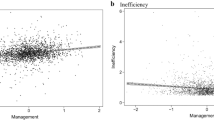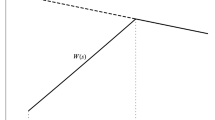Abstract
In this paper, we suggest that inefficiency may be an indirect, on-the-job compensation to agents in an organization. We show how to use actual production data to reveal the trade-offs between different inefficiencies (slacks). Moreover, we discuss how to use this to improve productivity analysis as well as decision making and incentive provisions in organizations.
Similar content being viewed by others
References
Afriat, S. (1972).“Efficiency Estimation of Production Functions”International Economic Review 13, 568–598.
Banker, R. D. and A. Maindiratta. (1988).“Nonparametric Analysis of Technical and Allocative Efficiencies in Production”Econometrica 56, 1315–1332.
Bogetoft, P. (1994a). Non-Cooperative Planning Theory. Springer-Verlag, pp. 1–314.
Bogetoft, P. (1994b).“Incentive Efficient Production Frontiers: An Agency Perspective on DEA”Management Science 40, 959–968.
Bogetoft, P. (1995).“Incentives and Productivity Measurements”International Journal of Production Economics 39, 67–81.
Bogetoft, P. (1997).“DEA-Based Yardstick Competition: The Optimality of Best Practice Regulation”Annals of Operations Research 73, 277–298.
Bogetoft, P. (2000).“DEA and Activity Planning under Asymmetric Information”Journal of Productivity Analysis 13, 7–48.
Bogetoft, P. and P. Pruzan. (1991). Planning with Multiple Criteria: Investigation, Communication and Choice. North-Holland.
Chavas, J. P. and T. L. Cox. (1990).“A Nonparametric Analysis of Productivity: The Case of U.S. and Japanese Manufacturing”American Economic Review 80, 450–464.
Chavas, J. P. and T. L. Cox. (1992).“On Generalized Revealed Preference Analysis”Quarterly Journal of Economics 74, 593–571.
Chavas, J. P. and T. L. Cox. (1995).“On Non-Parametric Supply Response Analysis”American Journal of Agricultural Economics 77, 80–92.
Cyert, R. M. and J. G. March. (1963). A Behavioral Theory of the Firm. Prentice Hall.
Debreu, G. (1951).“The Coefficient of Resource Utilization”Econometrica 19, 273–292.
DeAllessi, L. (1974).“An Economic Analysis of Government Ownership and Regulation: Theory and the Evidence from the Electric Power Industry”Public Choice 19, 1–42.
Dirickx, Y. M. I. and L. P. Jennergren. (1979). Systems Analysis by Multilevel Methods. John Wiley & Sons.
Farrell, M. J. (1957).“The Measurement of Productive Efficiency”Journal of the Royal Statistical Society, Series A III, 253–290.
Fä re, R. (1988). Fundamentals of Production Theory. Springer-Verlag.
Fä re, R. and S. Grosskopf. (1995).“Non-Parametric Tests of Regularity, Farrell Efficiency, and Goodness of Fit”Journal of Econometrics 69, 415–425.
Fodor, J. and M. Roubens. (1994). Fuzzy Preference Modelling and Multicriteria Decision Support. Klü wer Academic Publishers.
Galbraith, J. R. (1974).“Organizational Design: An Information Processing View”Interfaces 4, 28–36.
Grosskopf, S. and K. Hayes. (1993).“Local Public Sector Bureaucrats and Their Input Choices”Journal of Urban Economics 33, 151–166.
Halme, M., T. Joro, P. Korhonen, S. Salo and J. Wallenius. (1999).“A Value Efficiency Approach to Incorporating Preference Information in Data Envelopment Analysis”Management Science 45, 103–115.
Hanoch, G. and M. Rothschild. (1972).“Testing Assumptions of Production Theory: A Nonparametric Approach”Journal of Political Economy 80, 256–275.
Haskel, J. and A. Sanchis. (1995).“Privatisation and X-inefficiency: A Bargaining Approach”Journal of Industrial Economics 43, 301–321.
Haskel, J. and A. Sanchis. (2000).“A Bargaining Model of Farrell Inefficiency”International Journal of Industrial Organization 18, 539–556.
Johansen, L. (1977). Lectures on Macroeconomic Planning, Part I: General Aspects. North-Holland.
Johansen, L. (1978). Lectures on Macroeconomic Planning, Part II: Centralization, Decentralization, Planning under Uncertainty. North-Holland.
Koopmans, T. C. (1951).“Analysis of Production as an Efficient Combination of Activities”In T. C. Koopmans (ed.), Activity Analysis of Production and Allocation. New York: Wiley.
Lindsay, C. (1976).“A Theory of Government Enterprise”Journal of Political Economy 84, 1061–1077.
Leibenstien, H. (1966).“Allocative efficiency vs. 'X-efficiency'”The American Economic Review 56, 392– 415.
Leibenstein, H. (1978).“X-inefficiency Xists: Reply to an Xorcist”The American Economic Review 68, 203–211.
Leibenstein, H. and S. Maital. (1994).“The Organizational Foundation of X-inefficiency: A Game Theoretic Interpretation of Argyris' Model of Organizational Learning”Journal of Economic Behavior and Organization 23, 251–268.
Miguè J.L and G. Bèlanger. (1974).“Towards a General Theory of Managerial Discretion”Public Choice 17, 27–43.
Niskanen, W. A. (1971). Bureaucracy and Representative Government. Aldine Press.
Parish, R. and Y.-K. Ng. (1972).“Monopoly, X-efficiency and the Measurement of Welfare Loss”Economica 39, 301–308.
Peters, H. J. M. (1992). Axiomatic Bargaining Game Theory.Kluwer Academic Publishers.
Rawls, J. (1971). A Theory of Justice. Harvard University Press.
Samuelson, P. (1947). Foundations of Economic Analysis. Cambridge, Massachusetts: Havard University Press.
Stabler, U. and J. Sydow. (2002).“Organizational Adaptive Capacity: A Structuration Perspective”Journal of Management Enquiry, 11(4), 408–424.
Stigler, G. (1976).“The Xistence of X-efficiency”The American Economic Review 66, 213–216.
Shephard, R. W. (1970). Cost and Production Functions.Princeton University Press.
Tullock, G. (1967).“The Welfare Costs of Tariffs, Monopolies and Theft”Western Economic Journal 5, 224–232.
Varian, H. R. (1984).“The Non-Parametric Approach to Production Analysis”Econometrica 52, 279– 297.
Varian, H. R. (1985).“Non-Parametric Tests of Optimizing Behavior with Measurement Error”Journal of Econometrics 30, 445–458.
Varian, H. R. (1988).“Revealed Preference with a Subset of Goods”Journal of Economic Theory 46, 179– 185.
Varian, H. R. (1990).“Goodness-of-Fit in Optimizing Models”Journal of Econometrics 46, 125–140.
Weiss, A. (1990). Efficiency Wages: Models of Unemployment, Layoffs and Wage Dispersion. Princeton University Press.
Williamson, O. (1964). The Economics of Discretionary Behavior: Managerial Objectives in a Theory of the Firm. Prentice Hall.
Author information
Authors and Affiliations
Rights and permissions
About this article
Cite this article
Bogetoft, P., Hougaard, J.L. Rational Inefficiencies. Journal of Productivity Analysis 20, 243–271 (2003). https://doi.org/10.1023/A:1027347616038
Issue Date:
DOI: https://doi.org/10.1023/A:1027347616038




